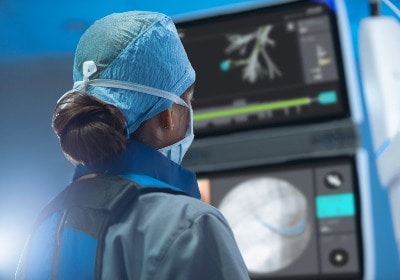Saving Lives From Lung Cancer
New Ion technology lets surgeons diagnose lung cancer earlier, enabling timely treatment and quick recovery.

Written by John Ferrari
Imagine going to the hospital for a routine heart CT scan and being told you have lung cancer. Now imagine you’re also told it can be surgically removed with no need for follow-up chemotherapy. It’s a whiplash bad news/good news situation, says Greg Wong, who underwent surgery to remove lung cancer in April.
“Everything happened really fast,” he recalls. “I went from not knowing there was anything wrong to ‘We have to do a biopsy’ to confirming stage 1 lung cancer. Then I went from ‘I have cancer, I could die,’ to ‘I’m cancer-free.’ All in 60 days.”
Wong’s success story was made possible by a team of Torrance Memorial Medical Center physicians, aided by some remarkable technology. The first is an AI program that processes CT scans and other medical imagery, highlighting suspicious features for radiologists to examine. The program automatically scanned an image of Wong’s chest taken as a routine precautionary measure to check for cholesterol buildup in his arteries (high cholesterol and hypertension run in his family).
Although the scan wasn’t intended to check for lung cancer, the AI program processed the entire image of his chest. In what’s called an incidental finding, it highlighted a shadow in his left lung above his heart. Wong’s primary care physician, Anthony Chen, MD, ordered a second scan, which confirmed a small lesion.
 The second is the Ion bronchoscopy platform, a robotic-assisted system for minimally invasive biopsies. “It’s essentially a navigation tool,” explains Khalid Eltawil, MD, a Torrance Memorial Physician Network board-certified physician specializing in internal medicine and pulmonary disease. “For a lesion like that, which was small in size and located at the edge of the lung, in the past we would have ordered a PET scan. But the smaller the spot, the less accurate a PET scan is. So when we’d see such a spot on a PET scan, we’d often elect to just watch it. The problem is, that gives the potential tumor a chance to grow and spread.”
The second is the Ion bronchoscopy platform, a robotic-assisted system for minimally invasive biopsies. “It’s essentially a navigation tool,” explains Khalid Eltawil, MD, a Torrance Memorial Physician Network board-certified physician specializing in internal medicine and pulmonary disease. “For a lesion like that, which was small in size and located at the edge of the lung, in the past we would have ordered a PET scan. But the smaller the spot, the less accurate a PET scan is. So when we’d see such a spot on a PET scan, we’d often elect to just watch it. The problem is, that gives the potential tumor a chance to grow and spread.”
The Ion system changes that dynamic—giving surgeons the ability to operate with unparalleled precision, navigating through tiny airways in the lungs to take biopsies of even the smallest lesions. First, Ion uses a CT scan to create a 3D map of the patient’s airways.
Then, during the procedure, “we are able to navigate using a virtual image,” Dr. Eltawil says. “The robotic arm has a camera, and the system can match the live view with the virtual view populated from the scan. There are two screens side by side: the map and the live view. We use it just like you would a navigation system.”
Being able to diagnose lung cancer at an early stage saves lives. “The earlier the stage, the better the outcome,” says Dr. Eltawil, who performed the biopsy. “Stage 1 cancers can essentially be cured. Early intervention also decreases the amount of lung that needs to be removed.”
“The Ion is a game changer,” agrees Clark Fuller, MD, director of thoracic surgery at Torrance Memorial, who removed the lesion. “It’s what we’ve been looking for in the arena of lung cancer for a long time. It changes the whole management paradigm—early detection, facilitating an early diagnostic procedure, resulting in earlier, definitive treatment—that’s what happened in Greg Wong’s case. The biopsy confirmed cancer, which would have been very difficult to do with a traditional biopsy. Because the surgery was performed at an early stage, it was a less-involved procedure. We were able to use a minimally invasive approach and remove less than a full lobe of his lung. That means a quicker and more complete recovery.”
Torrance Memorial is the only medical center in the South Bay to have adopted the Ion technology, says senior vice president and chief operating officer Derek Berz. Bringing in advanced technology like the Ion biopsy platform “is about providing great care so patients don’t have to leave the South Bay. Patients, both locally and from further away, come to Torrance Memorial to access treatment from these new technologies and to benefit from the experience and expertise of our physicians and clinical teams. If I’m a patient and I’m looking for a surgeon or a physician, I want to be sure they know what they’re doing. At Torrance Memorial, we’ve been keeping up with new technologies, and a lot of other hospitals simply don’t have the resources to do that.”
The bottom line, says Dr. Eltawil, is by using Ion to collect biopsies, “we can save patients unnecessary surgery. We’re able to diagnose cancers really early, before they become advanced. Lung cancer is the third most common cancer and has the highest mortality rate. With Ion we can diagnose lung cancer much earlier, before it spreads, and keep patients healthy.”
To ensure his recovery is on track, Wong has seen everyone on the team who treated him since his surgery, including his primary care physician, oncologist, pulmonologist and cardiologist. “I’m very pleased with how everything went at Torrance Memorial,” Wong says. “For me, it was a one-time procedure and you’re done.”